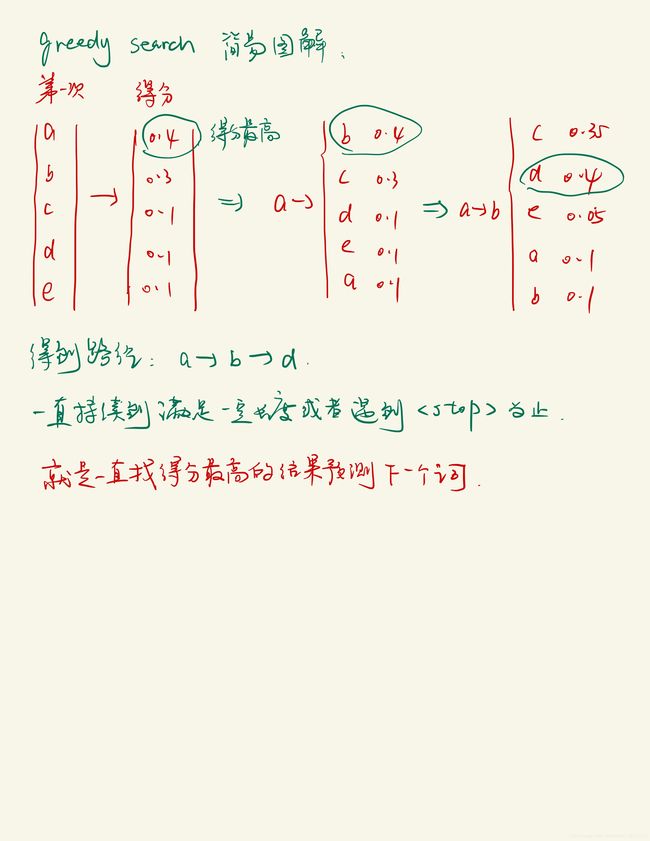beam_search 和 greedy_search方法
**
beam_search 和 greedy_search方法
**
1.beam_search方法
在seq2seq语言生成模型中,假设beam_size=2(就是每次搜索时选择最优的个数)在decoder预测的第一个词时,选择概率最大的两个词。举例就是:词表中有[a,b,c,d,e]五个词。第一次预测选择生成概率最大的a,b,对应的概率分别为0.4,0.35.(其他的c.d.e的概率为(0.1,0.1,0.05)),第二次预测选择第一次预测的结果的a和b座位decoder的输入,分别预测两个词。这样就有四个预测结果了,然后从预测结果中选择总体概率最大的两个。选择得分最大的两个路径的最后一个词作为decoder的输入继续预测下面的词,知道遇到 或者满足设置的长度。选择得分最高的路径作为最终结果。如下图所示:

tensorflow 2.0 beam_search code
class Hypothesis:
""" Class designed to hold hypothesises throughout the beamSearch decoding """
def __init__(self, tokens, log_probs, hidden, attn_dists):
self.tokens = tokens # list of all the tokens from time 0 to the current time step t
self.log_probs = log_probs # list of the log probabilities of the tokens of the tokens
self.hidden = hidden # decoder hidden state after the last token decoding
self.attn_dists = attn_dists # attention dists of all the tokens
self.abstract = ""
def extend(self, token, log_prob, hidden, attn_dist):
"""Method to extend the current hypothesis by adding the next decoded token and all the informations associated with it"""
return Hypothesis(tokens=self.tokens + [token], # we add the decoded token
log_probs=self.log_probs + [log_prob], # we add the log prob of the decoded token
hidden=hidden, # we update the state
attn_dists=self.attn_dists + [attn_dist])
@property
def latest_token(self):
return self.tokens[-1]
@property
def tot_log_prob(self):
return sum(self.log_probs)
@property
def avg_log_prob(self):
return self.tot_log_prob / len(self.tokens)
def print_top_k(hyp, k, vocab, batch):
text = " ".join([vocab.id_to_word(int(index)) for index in batch[0]])
print('\nhyp.text :{}'.format(text))
for i in range(min(k,len(hyp))):
k_hyp = hyp[i]
k_hyp.abstract = " ".join([vocab.id_to_word(index) for index in k_hyp.tokens])
print('top {} best_hyp.abstract :{}\n'.format(i, k_hyp.abstract))
def beam_decode(model, batch, vocab, params):
# 初始化mask
start_index = vocab.word_to_id(vocab.START_DECODING)
stop_index = vocab.word_to_id(vocab.STOP_DECODING)
unk_index = vocab.word_to_id(vocab.UNKNOWN_TOKEN)
batch_size = params['batch_size']
# 单步decoder
def decoder_one_step(enc_output, dec_input, dec_hidden):
# 单个时间步 运行
final_pred, dec_hidden, context_vector, attention_weights = model.call_decoder_onestep(dec_input,
dec_hidden,
enc_output)
# 拿到top k个index 和 概率
top_k_probs, top_k_ids = tf.nn.top_k(tf.squeeze(final_pred), k=params["beam_size"] * 2)
# 计算log概率
top_k_log_probs = tf.math.log(top_k_probs)
results = {
"dec_hidden": dec_hidden,
"attention_weights": attention_weights,
"top_k_ids": top_k_ids,
"top_k_log_probs": top_k_log_probs}
# 返回需要保存的中间结果和概率
return results
# 测试数据的输入
enc_input = batch
# 计算第encoder的输出
enc_output, enc_hidden = model.call_encoder(enc_input)
# 初始化batch size个 假设对象
hyps = [Hypothesis(tokens=[start_index],
log_probs=[0.0],
hidden=enc_hidden[0],
attn_dists=[]) for _ in range(batch_size)]
# 初始化结果集
results = [] # list to hold the top beam_size hypothesises
# 遍历步数
steps = 0 # initial step
# 长度还不够 并且 结果还不够 继续搜索
while steps < params['max_dec_len'] and len(results) < params['beam_size']:
# 获取最新待使用的token
latest_tokens = [h.latest_token for h in hyps]
# 替换掉 oov token unknown token
latest_tokens = [t if t in vocab.id2word else unk_index for t in latest_tokens]
# 获取所以隐藏层状态
hiddens = [h.hidden for h in hyps]
dec_input = tf.expand_dims(latest_tokens, axis=1)
dec_hidden = tf.stack(hiddens, axis=0)
# 单步运行decoder 计算需要的值
decoder_results = decoder_one_step(enc_output,
dec_input,
dec_hidden)
dec_hidden = decoder_results['dec_hidden']
attention_weights = decoder_results['attention_weights']
top_k_log_probs = decoder_results['top_k_log_probs']
top_k_ids = decoder_results['top_k_ids']
# 现阶段全部可能情况
all_hyps = []
# 原有的可能情况数量 TODO
num_orig_hyps = 1 if steps == 0 else len(hyps)
# 遍历添加所有可能结果
for i in range(num_orig_hyps):
h, new_hidden, attn_dist = hyps[i], dec_hidden[i], attention_weights[i]
# 分裂 添加 beam size 种可能性
for j in range(params['beam_size'] * 2):
# 构造可能的情况
new_hyp = h.extend(token=top_k_ids[i, j].numpy(),
log_prob=top_k_log_probs[i, j],
hidden=new_hidden,
attn_dist=attn_dist)
# 添加可能情况
all_hyps.append(new_hyp)
# 重置
hyps = []
# 按照概率来排序
sorted_hyps = sorted(all_hyps, key=lambda h: h.avg_log_prob, reverse=True)
# 筛选top前beam_size句话
for h in sorted_hyps:
if h.latest_token == stop_index:
# 长度符合预期,遇到句尾,添加到结果集
if steps >= params['min_dec_steps']:
results.append(h)
else:
# 未到结束 ,添加到假设集
hyps.append(h)
# 如果假设句子正好等于beam_size 或者结果集正好等于beam_size 就不在添加
if len(hyps) == params['beam_size'] or len(results) == params['beam_size']:
break
steps += 1
if len(results) == 0:
results = hyps
hyps_sorted = sorted(results, key=lambda h: h.avg_log_prob, reverse=True)
print_top_k(hyps_sorted, 3, vocab, batch)
best_hyp = hyps_sorted[0]
best_hyp.abstract = " ".join([vocab.id_to_word(index) for index in best_hyp.tokens])
# best_hyp.text = batch[0]["article"].numpy()[0].decode()
return best_hyp
2.greedy_search方法
和beam_search方法类似,只不过每次原则得分最高的预测结果去预测下面的词。如下图所示:

tensorflow 2.0
#使用encoder+attention+decoder
def greedy_decode(model, data_X, batch_size, vocab, params):
# 存储结果
results = []
# 样本数量
sample_size = len(data_X)
# batch 操作轮数 math.ceil向上取整 小数 +1
# 因为最后一个batch可能不足一个batch size 大小 ,但是依然需要计算
steps_epoch = math.ceil(sample_size / batch_size)
# [0,steps_epoch)
for i in tqdm(range(steps_epoch)):
batch_data = data_X[i * batch_size:(i + 1) * batch_size]
results += batch_greedy_decode(model, batch_data, vocab, params)
return results
def batch_greedy_decode(model, batch_data, vocab, params):
# 判断输入长度
batch_size = len(batch_data)
# 开辟结果存储list
preidicts = [''] * batch_size
inps = tf.convert_to_tensor(batch_data)
# 0. 初始化隐藏层输入
hidden = [tf.zeros((batch_size, params['enc_units']))]
# 1. 构建encoder
enc_output, enc_hidden = model.encoder(inps, hidden)
# 2. 复制
dec_hidden = enc_hidden
# 3. * BATCH_SIZE
dec_input = tf.expand_dims([vocab.word_to_id(vocab.START_DECODING)] * batch_size, 1)
context_vector, _ = model.attention(dec_hidden, enc_output)
# Teacher forcing - feeding the target as the next input
for t in range(params['max_dec_len']):
# 计算上下文
context_vector, attention_weights = model.attention(dec_hidden, enc_output)
# 单步预测
predictions, dec_hidden = model.decoder(dec_input,
dec_hidden,
enc_output,
context_vector)
# id转换 贪婪搜索
predicted_ids = tf.argmax(predictions, axis=1).numpy()
for index, predicted_id in enumerate(predicted_ids):
preidicts[index] += vocab.id_to_word(predicted_id) + ' '
# using teacher forcing
dec_input = tf.expand_dims(predicted_ids, 1)
results = []
for preidict in preidicts:
# 去掉句子前后空格
preidict = preidict.strip()
# 句子小于max len就结束了 截断
if vocab.STOP_DECODING in preidict:
# 截断stop
preidict = preidict[:preidict.index(vocab.STOP_DECODING)]
# 保存结果
results.append(preidict)
return results